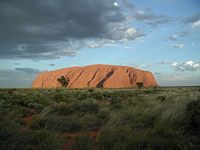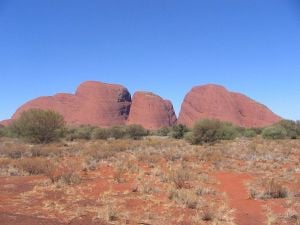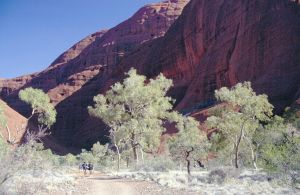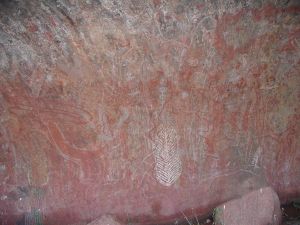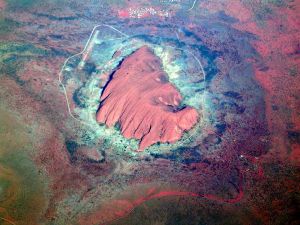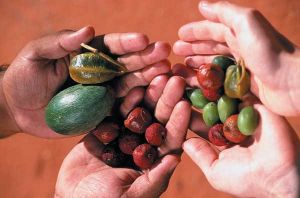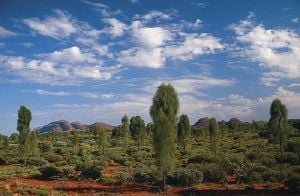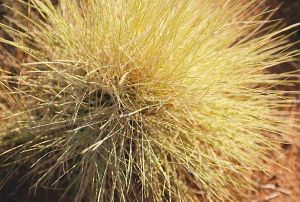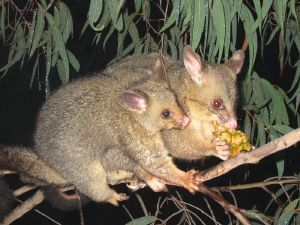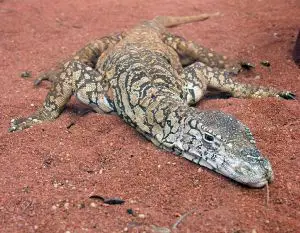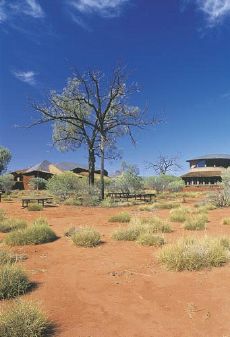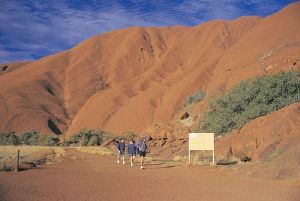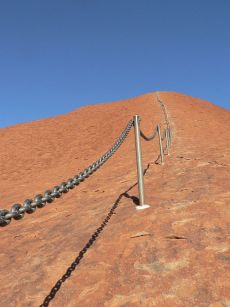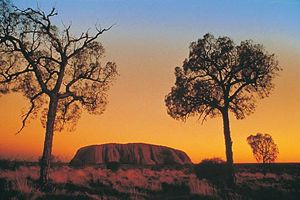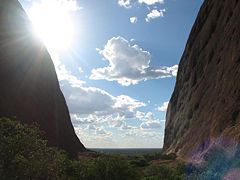Uluru-Kata Tjuta National Park
| Uluru-Kata Tjuta National Park* | |
|---|---|
| UNESCO World Heritage Site | |
Kata Tjuta, from the top of Uluru. | |
| State Party | |
| Type | Mixed |
| Criteria | v, vi, vii, ix |
| Reference | 447 |
| Region** | Asia-Pacific |
| Inscription history | |
| Inscription | 1987 (11th Session) |
| Extensions | 1994 |
| * Name as inscribed on World Heritage List. ** Region as classified by UNESCO. | |
Uluru-Kata Tjuta National Park is UNESCO World Heritage-listed in the Northern Territory of Australia. It is located 1431 kilometres south of Darwin by road and 440 kilometres south-west of Alice Springs along the Stuart and Lasseter Highways. The park covers 1326 square kilometres and includes the features it is named after - Uluru / Ayers Rock and, 40 kilometres to its west, Kata Tjuta / Mount Olga and is serviced by flights from most Australian capital cities.
Description
Uluru is one of the Northern Territory's most recognizable natural icons. It is a sandstone inselberg standing 348 meters (1142 feet) high with most of its bulk below the ground. Kata Tjuta, meaning ‘many heads’, is a group of 36 rock domes that dates back 500 million years. Both Uluru and Kata Tjuta have great cultural significance for the Anangu traditional landowners, who lead walking tours through the park to educate visitors about the local plants and animals, bush foods and the Aboriginal Dreamtime stories of the area.
Anangu are the traditional Aboriginal owners of Uluru-Kata Tjuta National Park. They believe their culture was created at the beginning of time by ancestral beings and has always existed in the Central Australian landscape. According to traditional lore, Uluru and Kata Tjuta provide physical evidence of feats performed during the creation period.
Both Uluru (also known as Ayers Rock) and Kata Tjuta (known as The Olgas) are considered sacred sites and thus important spiritually and cermonially to the Anangu. There are more than forty named sacred sites and eleven separate Tjurkurpa (or 'Dreaming') tracks in the area. Some of these dreaming tracks lead as far as the sea in all directions.
The Anangu have resided mostly in the northwest area of the state of South Australia, extending into the Northern Territory and a short distance into Western Australia. The land is an inseparable and important part of their identity, and every part of it is rich with stories and meaning to Anangu.
While political borders have generally held little meaning for indigenous peoples, the border separating the Northern Territory and South Australia served as an impediment to the Anangu in their claim to the sacred lands. The Aboriginal Land Rights (Northern Territory) Act was passed in 1976, meaning that after many years Aboriginal law and land rights were finally recognized in Australian law. In 1979 the Central Land Council, which represents the indigenous people predominantly in land issues, laid claim to the area that eventually became Uluru-Kata Tjuta National Park. This claim was fiercely resisted by the Northern Territory government.
After eight years of intensive lobbying by the Traditional Owners, Prime Minister Bob Hawke announced that the Federal Government intended to transfer inalienable freehold title to them. He also agreed to ten main points they had demanded in exchange for a lease-back arrangement to the Australian National Parks and Wildlife Service for a "joint-management" system in which Anangu would have a majority on the Board of Management. This was finally granted in 1985, but with the government rejecting two of the most important points the Anangu had requested: they were forced to agree to lease the Park for 99 years, instead of the fifty years originally agreed on, perhaps more importantly, they had to allow tourists to climb Uluru, which they believed was an act of desecration of one of their main dreaming tracks. Park Management has erected signs asking visitors not to climb the "Rock," but have no authority to enforce it, and many thousands of visitors are said to climb the rock every year.
In spite of the disagreements, since hand-back, Anangu and Parks Australia staff have worked together to manage the Park. Management policy and programs seek to maintain Anangu culture and heritage, conserve and protect the integrity of the ecological systems in and around the Park while providing for visitor enjoyment and educational opportunities within the Park.
Park establishment
In 1987, Uluru National Park was listed as a UNESCO World Heritage Site for the conservation of nature. In 1993 the official name of the Park changed to Uluru-Kata Tjuta National Park. In 1994 UNESCO extended its designation to recognize the park's cultural significance.
In 1995 Parks Australia and the Uluru-Kata Tjuta Board of Management won the Picasso Gold Medal, the highest UNESCO award for outstanding preservation efforts of the park. They were noted for setting new international standards for World Heritage management.
The National Parks and Wildlife Conservation Act 1975 was replaced in July 2000 by the Environment Protection and Biodiversity Conservation Act 1999. The declaration of the Park was continued under the new Act.
History
Europeans came to the western desert area of Australia in the 1870s. Uluru and Kata Tjuta were first mapped by Europeans during the expeditionary period made possible by the construction of the Overland Telegraph Line in 1872.
In separate expeditions, William Ernest Powell Giles and William Christie Gosse were the first European explorers to this area. In 1872 while exploring the area, Ernest Giles sighted Kata Tjuta from near Kings Canyon and called it Mount Olga, while the following year Gosse saw Uluru and named it Ayers Rock after Sir Henry Ayers, the Chief Secretary of South Australia. Further explorations followed with the aim of establishing the possibilities of the area for pastoralism.
In the late 1800s, pastoralists attempted to re-establish themselves in areas adjoining the South-Western/Petermann Reserve and interaction between Anangu and white people became more frequent and more violent. Due to the effects of grazing and droughts, bush food stores were depleted. Competition for these resources created conflict between pastoralists and Anangu. As a result police patrols became more frequent.
Between 1918 and 1921 large adjoining areas of South Australia, Western Australia and the Northern Territory were declared as Aboriginal reserves, as sanctuaries for a nomadic people who had virtually no contact with white people. In 1920, part of Uluru-Kata Tjuta National Park was declared an Aboriginal Reserve (commonly known as the South-Western or Petermann Reserve) by the Australian Government under the Aboriginals Ordinance (NT).
During the depression in the 1930s, Anangu became involved in dingo scalping with ‘doggers’ who introduced Anangu to European foods and ways. The first tourists visited the Uluru area in 1936.
"From the 1940s the two main reasons for permanent and substantial European settlement in the area were Aboriginal welfare policy and the promotion of tourism at Uluru."[1]
"In 1948 the first vehicular track to Uluru was constructed, responding to increasing tourism interest in the region. Tour bus services began in the early 1950s."[1]
"In 1958, in response to pressures to support tourism enterprises, the area that is now the Park was excised from the Petermann Aboriginal Reserve to be managed by the Northern Territory Reserves Board as the Ayers Rock - Mt Olga National Park. The first ranger was the legendary central Australian figure, Bill Harney.."[1]
By 1959 the first motel leases had been granted and Eddie Connellan had constructed an airstrip close to the northern side of Uluru.
Climate and seasons
The park receives an average rainfall of 307.7 millimeters per year. Temperature extremes in the park have been recorded at 45°C (113°F) during the summer and -5°C (23°F) during winter nights. UV readings on most extreme summer days reach between 11 and 15.[2] While the Central Australian environment may at first seem stark - a barren landscape supporting spectacular rock formations - closer inspection reveals it as a complex ecosystem, full of life.
Plant and animal life have adapted to the area's extreme conditions and it subsequently supports some of the most unusual flora and fauna on the planet. Many of these have long been a valuable source of bush tucker and medicine for local Aboriginal people who recognise six seasons:
- Piryakatu (August/September) - Animals breed and food plants flower
- Wiyaringkupai (October/November) - The really hot season when food becomes scarce
- Itanju- (January/February) Sporadic storms can roll in suddenly
- Wanitjunkupai (March) - Cooler weather
- Tjuntalpa (April/May) - Clouds roll in from the south
- Wari (June/July) - Cold season bringing morning frosts
From a geological point of view, analysis of Uluru-Kata Tjuta and Watarrka National Parks reveals an awe-inspiring history. 500 million years ago, the entire area was covered by an inland sea and over many centuries, sand and mud fell to the bottom of the sea, creating rock and sandstone. Kata Tjuta's domes are the eroded remains of sedimentary rock from the seabed, while Uluru is a relic of the coarse grained, mineral-rich sandstone called arkose.
Flora
Uluru-Kata Tjuta National Park flora represents a large portion of plants found in Central Australia. A number of these species are considered rare and restricted in the Park or the immediate region. There are many rare and endemic plants at Uluru and Kata Tjuta. A number of other species, while found elsewhere in central Australia, may be endangered within the Park.
The desert flora has adapted to the harsh conditions. The growth and reproduction of plant communities rely on irregular rainfall. Some plants are able to survive fire and some are dependent on it to reproduce. Plants are an important part of Tjukurpa, and there are ceremonies for each of the major plant foods. Many plants are associated with ancestral beings. Collection of plant foods remains a culturally important activity, reinforcing traditional links with country and Tjukurpa.
Flora in Uluru-Kata Tjuta National Park can be broken into the following categories:
- Punu – trees
- Puti – shrubs
- Tjulpun-tjulpunpa – flowers
- Ukiri - grasses
Trees such as the mulga and centralian bloodwood are used to make tools such as spearheads, boomerangs and bowls. The red sap of the bloodwood is used as a disinfectant and an inhalant for coughs and colds.
Others such as the river red gum and corkwood trees like grevillea and hakeas are a source of food themselves. The white flaky crust from river red gum leaves can be rolled into balls and eaten like a lolly and the nectar from the flowers of the corkwood trees can produce a sweet drink.
The witchetty bush looks like a shrubby mulga with broad round-ended leaves. Witchetty grubs are found in the roots of this tree. Daisies and other ground flowers bloom after rain and during the winter. Others such as the wattles bloom as spring approaches. Anangu collect wattle seed, crush and mix it with water to make an edible paste which they eat raw. To make damper, the seeds are parched with hot sand so their skins can be removed before they are ground for flour.
The prickly hard spinifex hummocks have enormous root systems that prevent desert sands shifting. The hummock roots spread underground beyond the prickly clump and deeply into the soil, forming an immense cone. Anangu use a resin gathered from the gummy spinifex to make gum. They thresh the spinifex until the resin particles fall free. These particles are heated until they fuse together to form a moldable black tar which Anangu work while warm. The gum is used for hunting and working implements, and to mend breaks in stone and wooden implements.
The naked woolybutt and native millet have seeds that are important Anangu foods. Women rub the seed heads from their stalks and then separate the seeds from the chaff by skilful winnowing. Using grinding stones, they then grind the seeds to flour for damper.
There are several rare and endangered species in the Park. Most of them like adder's tongue ferns (Ophioglossaceae Sp.) are restricted to the moist areas at the base of the monoliths, which are areas of high visitor use and subject to erosion.
Since the first Europeans arrived, 34 exotic plant species have been recorded in the Park, representing about 6.4% of the total park flora. Some such as perennial buffel grass (Cenchrus ciliaris) were introduced to rehabilitate areas damaged by erosion. It is the most threatening weed in the Park and has spread to invade water and nutrient rich drainage lines. Where infestation is dense, it prevents the growth of native grasses - a source of food for animals and humans. A few others such as burrgrass were brought in accidentally, carried on cars and people.
Fauna
Historically 46 species of native mammal are known to have been living in the Uluru region; there are currently 21 according to recent surveys. Anangu acknowledge that a decrease in the number has implications for the condition and health of the landscape. Moves are supported for the reintroduction of locally extinct animals such as mallee fowl, brushtail possum, rufous hare wallaby, or mala, bilby, burrowing bettong and the black footed rock wallaby.
The mulgara, the only mammal listed as vulnerable, is mostly restricted to the transitional sandplain area, a narrow band of country that stretches from the vicinity of Uluru, to the Northern boundary of the Park, and into Ayers Rock Resort. This very important area also contains marsupial mole, woma python, or kuniya, and great desert skink.
The bat population of the Park comprises at least seven species that depend on day roosting sites within caves and crevices of Uluru and Kata Tjuta. Most of the bats forage for aerial prey within an airspace extending only 100 m or so from the rock face.
The Park has a very rich reptile fauna of high conservation significance with 73 species having been reliably recorded. Four species of frog are abundant at the base of Uluru and Kata Tjuta following summer rains. The great desert skink is listed as vulnerable.
Anangu continue to hunt and gather animal species in remote areas of the Park and on Anangu land elsewhere. Hunting is largely confined to the red kangaroo, Australian bustard, emu and lizard such as the sand goanna and perentie.
The pressures exerted by introduced predators and herbivores on the original mammalian fauna of Central Australia were a major factor in the extinction of about 40% of the native species.
Of the 27 mammal species found in the Park, six are introduced: the house mouse; camel; fox; cat; dog; and rabbit. These species are distributed throughout the Park but their densities are greatest in the rich water run off areas of Uluru and Kata Tjuta.
Large numbers of rabbits led to the introduction of a rabbit control program in 1989. This has resulted in a great reduction of the rabbit population, a noticeable vegetation recovery and a reduction in predator numbers.
Camels have been implicated in the reduction of plant species, particularly the more succulent species such as the quandong. The house mouse is a successful invader of disturbed environments and habitats that have lost native rodents.
Subjective estimates of cat and fox numbers have been collected in association with the rabbit control program. The national threat abatement programs may provide the framework for controlling them. Anangu knowledge and tracking skills are invaluable in the management of these introduced animals. The Park regulations prohibit visitors bringing animals into the Park unless they are a guide dog for the blind or deaf, or a permit is granted by the Director of National Parks.
Human impacts
The Uluru climb is the traditional route taken by ancestral Mala men upon their arrival to Uluru. Anangu do not climb Uluru because of its great spiritual significance. Anangu have not closed the climb. They prefer that visitors - out of education and understanding - choose to respect their law and culture by not climbing. The Cultural Centre in the Park has information on this for visitors.
The Valley of the Winds walk is an excellent alternative to climbing Uluru and offers views of the spectacular landscape from two lookout points along the track. The walk is sometimes steep, rocky and difficult. For safety reasons this walk is closed under certain circumstances including heat, darkness and during rescue.[3]
The Aboriginal community of Mutitjulu is inside the park area, but tourists must stay at the resorts in Yulara. The national park and town are served by Connellan Airport.
Ecology
The Park is ranked as one of the most significant arid land ecosystems in the world. As a Biosphere Reserve under the UNESCO Man and the Biosphere Program, it joins at least 11 other reserves in Australia and an international network aiming to preserve the world's major ecosystem types.
Fire management
Fires have been a part of central desert land management for thousands of years and have shaped the landscape, habitats, survival of animals and patterns of vegetation. Controlled burning usually takes place during the winter months due to the cooler weather while natural fires mostly occur in the early summer months. They are usually started by the lightning strikes of dry electrical storms from the north west. When the storms arrive the weather is usually hot, dry and windy - conditions ideal for raging fires. Damage can be severe and widespread. Destructive bushfires burnt much of Uluru-Kata Tjuta National Park and luxury accommodation at the Ayers Rock Resort was destroyed in 2002-03.
Traditional burning of the Uluru area stopped when Anangu were driven from the region during the 1930s. During the 1940s rainfall was good and vegetation flourished. The 1950 fire, fed by the fuel grown during the previous 20 years, wiped out about one third of Uluru-Kata Tjuta National Park's vegetation. The pattern repeated itself and in 1976 two fires burnt 76% of the Park. Over the same period more species of medium sized mammals became extinct around Uluru and Kata Tjuta.
Today most fires in the park are lit following land management patterns traditionally practiced by Anangu (Aboriginal people). Traditional fire and land management skills enable Anangu to burn in a way that will give the desired result. These skills are vital for the preservation of the central Australian ecology.
Tourism
The development of tourism infrastructure adjacent to the base of Uluru that began in the 1950s soon produced adverse environmental impacts. It was decided in the early 1970s to remove all accommodation related tourist facilities and re-establish them outside the Park. In 1975 a reservation of 104 square kilometres of land beyond the park's northern boundary, 15 kilometres from Uluru, was approved for the development of a tourist facility and an associated airport, to be known as Yulara. The campground within the Park was closed in 1983 and the motels finally closed in late 1984, coinciding with the opening of the Yulara resort. In 1992 the majority interest in the Yulara Resort held by the Northern Territory Government was sold and the resort was renamed 'Ayers Rock Resort'.
The listing of Uluru - Kata Tjuta National Park ensures the Park remains a world-class destination for both its cultural and natural heritage. Visitors will continue to have a unique cultural experience at the Park and leave knowing that the Park is managed according to cultural practices that date back tens of thousands of years.
Since listing the Park as World Heritage annual visitor numbers have risen to over 400,000 visitors in the year 2000. Increased tourism provides regional and national economic benefits. It also presents an ongoing challenge to balance conservation of cultural values and visitor needs.[4]
Anangu Tours is a company offering small and exclusive group tours around Uluru led by local Aboriginal guides. Kata Tjuta has several walks that can be taken throughout the day including the famous Valley of the Winds walk.
There are a number of walks that visitors can take around the major attractions of the Park. The Base Walk is one of the best ways to see Uluru. Other walks surrounding Uluru include the Liru Walk, Mala Walk and Kuniya walk, while the sunrise and sunset viewing areas provide great photo opportunities.[5]
Park management
On 26 October 1985, the Governor General Sir Ninian Stephen presented the Uluru-Kata Tjuta National Park title deeds back to Anangu, the traditional owners.
Leading up to 1985 were many years of negotiation for Anangu to become the legal owners of their traditional land. They wanted the right to look after the area in what they believed to be the proper way. Anangu became increasingly concerned that their traditional lands were under pressure from pastoralism, mining and tourism.
In 1971 there were meetings held in Ernabella by the Office of Aboriginal Affairs where traditional owners of Uluru expressed their concerns. Paddy Uluru spoke about Uluru and voiced concerns at the desecration of sites by tourists. Senior Aboriginal people asked the Federal Government for help in protecting these sites.
In 1973 the Federal House of Representatives’ Standing Committee on Environment and Conservation prepared a report on the Park. After talking with tourist operators and Traditional Owners the committee concluded that the Park be managed by the Federal Parks and Wildlife Service. It was suggested that Aboriginal people could be involved in Park management. It also suggested creating a suitable living area for Anangu to help facilitate their involvement in the Park. These recommendations were carried out and a bore and camp-ground was established.
In 1985 the Park was granted as Aboriginal land and began to be jointly managed by Anangu and the Commonwealth. It was agreed between Anangu would lease the Park to the Government for 99 years and that Anangu would receive an annual rent and share of Park revenue.
At a major ceremony at the Park on 26 October 1985, with the deeds of grant under the Land Rights Act was delivered by the Governor General, Sir Ninian Stephen. The lease document was signed at the same time by the newly formed Uluru - Kata Tjuta Aboriginal Land Trust and the Director of National Parks. This occasion formally acknowledged Anangu ownership of the Park whilst at the same time recognising the value of their land as a park of national and international importance.
The Uluru-Kata Tjuta Board of Management was established under the National Parks and Wildlife Conservation Act 1975 on 10 December 1985 and held its first meeting on 22 April 1986. The Board of Management continues under the Environment Protection and Biodiversity Conservation Act 1999.
The lease agreement ensures that the Director of National Parks:
- has an Anangu majority on the Board of Management
- encourages the maintenance of Anangu tradition through protection of sacred sites and other areas of significance
- maximises Anangu involvement in Park administration and management, and provides necessary training
- delivers training programs to Anangu to enable them to take up employment in the Park
- maximises Anangu employment in the Park by accommodating Anangu needs and cultural obligations with flexible working conditions
- uses Anangu traditional skills in Park management
- actively supports the delivery of cross-cultural training by Anangu to Park staff, local residents and Park visitors
- consults regularly with Anangu
- encourages Anangu commercial activities in the Park
- makes rental payments to the members of the Uluru - Kata Tjuta lands trust
- maintains the Park to best practice standards
- involves Anangu in staff selection
Of the 12 members of the Board of Management:
- Eight Aboriginal members are nominated by the Anangu traditional owners
- One member is nominated by the federal minister responsible for tourism and approved by Anangu
- One member is nominated by the federal minister responsible for the environment and approved by Anangu
- One member is nominated by the Northern Territory Government and approved by Anangu
- One member is the Director of National Parks.
Board members usually sit for a term of five years before a new nomination process takes place. All nominees are appointed by the Minister for the Environment and Water Resources after a consultation process. Board meetings are held at least four times a year with all matters discussed in both English and Pitjantjatjara and/or Yankunytjatjara.
Tjukurpa guides the development and interpretation of Park policy as set out in the Plan of Management. Plans of Management are developed in consultation with Anangu and a wide range of individuals and organisations associated with the Park. Park Management programs are all guided by Tjukurpa.
General Facilities
The Park is open year round from sunrise to sunset. These times will vary depending on the season. Occasionally parts of the Park may be temporarily closed for cultural reasons.
The park entrance fee for Uluru-Kata Tjuta National Park is $25 per person 16 years of age and over. This fee is valid for 3 consecutive days and helps to maintain the Park. One quarter goes back to Anangu, the traditional owners, to help them maintain their families and the Mutitjulu community.
The Uluru-Kata Tjuta National Park Cultural Centre, located inside the Park on the main road to Uluru, provides an introduction to Tjukurpa (law, knowledge, religion, philosophy), Anangu art, Anangu way of life (traditional and current), history, languages, wildlife and joint management of the Park. There are also art and craft demonstrations, bush tucker sessions, plants walks and cultural presentations.
There are displays featuring photo collages, oral history sound panels, Pitjantjatjara language learning interactives, soundscapes, videos and artefacts. Explanations are provided in Pitjantjatjara, English, Italian, Japanese, German and French. A touch wall for visually impaired people ensures that the messages are accessible to everyone. Entry to the Cultural Centre is free.
The Walkatjara Art Centre is owned and operated by the local Aboriginal artists from the Mutitjulu Community. Most weekdays the Walkatjara Artists come to paint and work in the Art Room and receive a percentage of sales.
Accommodation
The Aboriginal community of Mutitjulu is inside the park area, but tourists must stay at the resorts in Yulara. Ayers Rock Resort, just outside the national park in the township of Yulara, offers a range of accommodation from camp sites to five-star luxury.
There’s also the luxury tented accommodation at Longitude 131, with views of Uluru from the tents. There are also several dining options, a supermarket and a range of tour operators. Ayers Rock Resort is located just outside the Park. It has a range of accommodation to suit all budgets and tastes. Camping is not permitted in the Park.
Kata Tjuta, sometimes written Kata Tjuta, and also known as Mount Olga (or colloquially as The Olgas), are a group of large domed rock formations located about 365 km southwest of Alice Springs, in the southern part of the Northern Territory, central Australia. Uluru, 25 km to the east and Kata Tjuta form the two major landmarks within the Uluru-Kata Tjuta National Park. The 36 domes, covering an area of 21.68 km², are composed of conglomerate, a sedimentary rock consisting of cobbles and boulders of varying rock types including granite and basalt, cemented by a matrix of sandstone. The highest point, Mount Olga, is 1066 m above sea level, or approximately 546 m above the surrounding plain (203 m higher than Uluru).[6] Kata Tjuta is located at the eastern end of the Docker River Road.
Name
The Pitjantjajara name Kata Tjuta means 'many heads'. The site is as sacred to the Indigenous people as Uluru.
The alternative name, The Olgas, comes from the tallest peak, Mt Olga. At the behest of Baron Ferdinand von Mueller, Mt Olga was named in 1872 by Ernest Giles, in honour of Queen Olga of Württemberg. She and her husband King Karl had marked their 25th wedding anniversary the previous year by, amongst other things, naming Mueller a Freiherr (baron), making him Ferdinand von Mueller; this was his way of repaying the compliment.[7]
On 15 December 1993, a dual naming policy was adopted that allowed official names consisting of both the traditional Aboriginal name and the English name. As a result, Mount Olga was renamed Mount Olga / Kata Tjuta. On 6 November 2002, following a request from the regional Tourism Association, the order of the dual names were officially reversed to Kata Tjuta / Mount Olga.[8]
Legends
There are many Pitjantjatjara Dreamtime legends associated with this place and indeed everything in the vicinity including, of course, Uluru. A number of legends surround the great snake Wanambi who is said to live on the summit of Mount Olga and only comes down during the dry season.
Spiritual importance
Many ceremonies were, and are still carried out here, particularly at night. One of these former ceremonies included a type of public punishment that in extreme cases included death.
Transportation
Kata Tjuta can be accessed via Ayers Rock Airport. It is then a 55 km drive south, then west. Visitors are required to pay a National Park [1] entry fee, which is currently $25 AUD per person. Visitors can also drive along the Lasseter Highway which joins the Stuart Hwy 200 m south of Alice Springs at the township of Erldunda. The drive is 4½ hours from Alice Springs.
Notes
- ↑ 1.0 1.1 1.2 Uluru - Kata Tjuta Board of Management and Parks Australia (2000) Fourth Uluru - Kata Tjuta National Park Plan of Management. Commonwealth of Australia. Canberra. Page 7.
- ↑ Welcome to Aboriginal land: Uluru-Kata Tjuta National Park; visitor guide and maps, Colemans Printing, Darwin, January 2006.
- ↑ Nt GovernmentDepartment of Environment and water resources (www.environment.gov.au/parks/uluru)
- ↑ Tourism NTTourism NT (www.tourismnt.com.au)
- ↑ Tourism Information SiteTourism Information Site (www.travelnt.com.com.au)
- ↑ Uluru-Kata Tjuta National Park Visitors Guide. Retrieved 12 May 2007
- ↑ Whitlam Institute, University of Western Sydney. Retrieved 28 March 2007
- ↑ Northern Territory Government — NT Place Names Register. Retrieved 17 November 2007
ReferencesISBN links support NWE through referral fees
External links
- World heritage listing for Uluru-Kata Tjuta National Park
- Travel guide to Uluru-Kata Tjuta National Park from Wikitravel
- Official Tourism Information Site
Credits
New World Encyclopedia writers and editors rewrote and completed the Wikipedia article in accordance with New World Encyclopedia standards. This article abides by terms of the Creative Commons CC-by-sa 3.0 License (CC-by-sa), which may be used and disseminated with proper attribution. Credit is due under the terms of this license that can reference both the New World Encyclopedia contributors and the selfless volunteer contributors of the Wikimedia Foundation. To cite this article click here for a list of acceptable citing formats.The history of earlier contributions by wikipedians is accessible to researchers here:
The history of this article since it was imported to New World Encyclopedia:
Note: Some restrictions may apply to use of individual images which are separately licensed.

